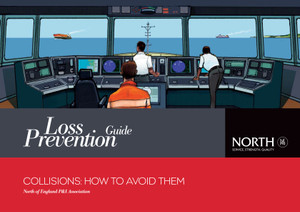
This publication explains the actions personnel can take to avoid shipping incidents. It details the ship’s navigational system and procedures for voyage planning, the need for effective bridge team management and both virtual and physical watchkeeping. All of these factors are designed to reduce the risk of incidents.
This guide is designed to bring to the attention of Masters and officers the key factors that contribute to groundings and fixed floating object damage. It tests readers’ understanding of navigational equipment and onboard training, encouraging crew to test one another during voyage preparation. The book aims to promote an understanding of how risks can be minimised through following good practice. Most chapters are supported by case studies that highlight poor practice and ask readers to reflect on alternative options.
Ship groundings and fixed and floating object (FFO) damage – the term used when a ship damages property other than another ship – are among the highest profile and most costly of maritime accidents. The cost in both personal and financial terms has increased in recent years, but human error remains the most common factor. Groundings and FFO incidents are rarely caused by a single factor. They are usually explained by a combination of factors that, together, cause an incident.
A ship’s navigational system and procedures for voyage planning, bridge team management and watchkeeping are designed to reduce the risk of incidents. All are interdependent, and it is when these systems and procedures start to break down that incidents occur.
Every voyage, and the plans made in support of the voyage, is part of one complex, sometimes confusing, and always changing system. Each and every component of the voyage is reliant on all of the other components to ensure that a ship, the crew, its cargo and the environment are kept safe.
Systems do not break down by themselves and procedures do not bypass themselves; it is the incorrect actions or omissions of the people using the system and/or procedures that cause them to break down. If you are part of the bridge team, it is your responsibility to ensure that the systems are properly used and implemented. Remember, as a member of the bridge team it is your responsibility to ensure that your ship is kept safe during a voyage.
This guide is not intended as a textbook on voyage planning and the avoidance of groundings or FFO incidents. It is designed to bring to the attention of ships’ officers the key factors that we at North, based on many years of extensive experience in dealing with such incidents, believe are the key contributory factors in groundings and FFO incidents.
The guide includes suggestions on avoiding these contributory factors and aims to promote an understanding of how the risks can be minimised through following good practice.
In
addition,
one
or
more
case
studies
are
included
at
the
end
of
most
chapters
to
provide
examples
of
poor
practice.
Based
on
real
groundings
and
FFO
incidents,
each
case
study
describes
a
developing
situation
and
asks
a
number
of
questions
−
but
the
answers
are
not
provided.
The
intention
is
to
encourage
thought
by,
and
discussion
between,
members
of
the
bridge
team
so
that
they
may
consider
the
factors
that
contributed
to
the
incidents
and
how
they
could
have
been
avoided.
It is much less costly to learn from the mistakes of others than to learn from your own mistakes.
Chapter 1 It is Your Responsibility
1.1 Groundings
1.2 Fixed and Floating Objects
1.3 Summary
Chapter 2 Voyage Planning
2.1 IMO Guidelines
2.2 Preparing the Voyage Plan
2.3 Summary
Chapter 3 Monitoring of the Voyage Plan
3.1 Position Monitoring
3.2 Looking Ahead and Real Time Monitoring
3.3 Passing ‘The Con’
3.4 Summary
Chapter 4 Departure from the Voyage Plan
4.1 Summary
Chapter 5 Aids to Navigation
5.1 Testing Each Other’s Knowledge
5.2
Are
You
a
Virtual
Watchkeeper?
5.3
Summary
Chapter 6 Navigating with A Pilot on Board
6.1 IMO Recommendations
6.2 Pre-arrival Information
6.3 Berth to Berth Plan
6.4 Master–Pilot Exchange (MPX)
6.5 Monitoring a Vessel During Pilotage
6.6 Monitoring the Pilot
6.7 Maintaining the Master’s Authority
6.8 On Board Training and Procedures
6.9 Summary
Chapter 7 The Bridge Team
7.1 Teamwork and Communication
7.2 Understanding Cultural Issues
7.3 Summary
Chapter
8
Situational
Awareness
8.1
Information
Overload
8.2 Complacency
8.3 Fatigue
8.4 Poor Communication
8.5 Summary
Chapter 9 Fatigue
9.1 Summary
Chapter 10 Speed and Angle of Approach
10.1 Speed
10.2 Angle of Approach
10.3 Summary
Chapter 11 Tugs
11.1 Planning Tug Operations
11.2 Summary
Chapter 12 Weather Conditions
12.1 Wind
12.2 Restricted Visibility
12.3 Sea State
12.4 Summary
Chapter 13 Machinery Problems
NorthStandard is one of the leading providers of global marine insurance products and services across the maritime industries. Established through the merger of North P&I Club and the Standard Club in February 2023, NorthStandard brings together over 300 years of marine insurance heritage.
From headquarters in the UK and with offices throughout Europe, Asia and the Americas, NorthStandard offers a unique blend of worldwide presence and class-leading expertise across multiple specialist areas, including P&I, FD&D, War Risks, Strike & Delay, Hull and Machinery and ancillary insurance. Its Sunderland Marine and Coastal & Inland divisions also provide cover for owners’ fixed premium P&I, fishing vessels, inland waterway and coastal trading vessels and aquaculture. NorthStandard’s comprehensive local market and sector knowledge is underpinned by continuous investments in market-leading digital technologies.
NorthStandard is a leading member of the International Group of P&I Clubs (IG) and is fully committed to upholding the shared objectives of its 12 independent member clubs, which provide liability cover for approximately 90% of the world’s ocean-going tonnage.
- Number of Pages:
- 42
- ISBN:
- 9780957493629
- Binding Format:
- Paperback
- Book Height:
- 210 mm
- Book Width:
- 147 mm
- Weight:
- 0.2 kg
- Author:
NorthStandard
- Published Date:
- August 2019
- Preview:
- Yes
- Publication Date:
- August 2019






